Understanding the Vietnam climate is crucial for trip planning due to its diverse weather across regions.
Northern Vietnamhas cool winters and hot summers, with the best travel times being in spring and fall.Central Vietnamfeatures warm temperatures year-round, with a rainy season from September to December and ideal travel from February to May.Southern Vietnamenjoys a tropical climate with consistent warmth, a dry season from November to April, and a rainy season from May to October, making December to February the most pleasant for visitors. Packing appropriately, staying hydrated, and planning around the weather will enhance your travel experience.
Northern Vietnam weather
Northern provinces, including cities like Hanoi, Ha Long Bay, and Sa Pa, have a humid subtropical climate. This region has four distinct seasons: spring, summer, autumn, and winter. The Vietnam climate in the north is characterized by its variety of weather throughout the year.
Spring seasons in Northern (March to April)
During spring, temperatures in Northern Vietnam range from 15°C to 20°C (59°F to 68°F). This season features blooming flowers, making it a picturesque time to visit. The landscape is dotted with vibrant peach blossoms and other floral displays, creating stunning scenery, especially in areas like Hanoi. Rainfall is relatively low, and the humidity is moderate, making outdoor activities enjoyable. It is an ideal time to explore the cultural sites and natural beauty of Northern Vietnam without the discomfort of extreme temperatures.

Things you might be interested in:
Summer seasons in Northern (May to August)
The Northern Vietnam summer is hot and humid, with temperatures often exceeding 30°C (86°F). June and July are the hottest months, with temperatures reaching up to 40°C (104°F). This period coincides with the monsoon season in Vietnam, bringing heavy rainfall and frequent thunderstorms. The intense heat and high humidity can be challenging for some travelers, and the heavy rains may disrupt outdoor plans. However, the lush green landscapes and vibrant nature scenes make it a visually striking time to visit.
Despite the heat, summer is a great time for beach activities in coastal areas like Cat Ba Island. It’s also a good time for exploring the cooler highlands of Sapa and enjoying indoor attractions in Hanoi.
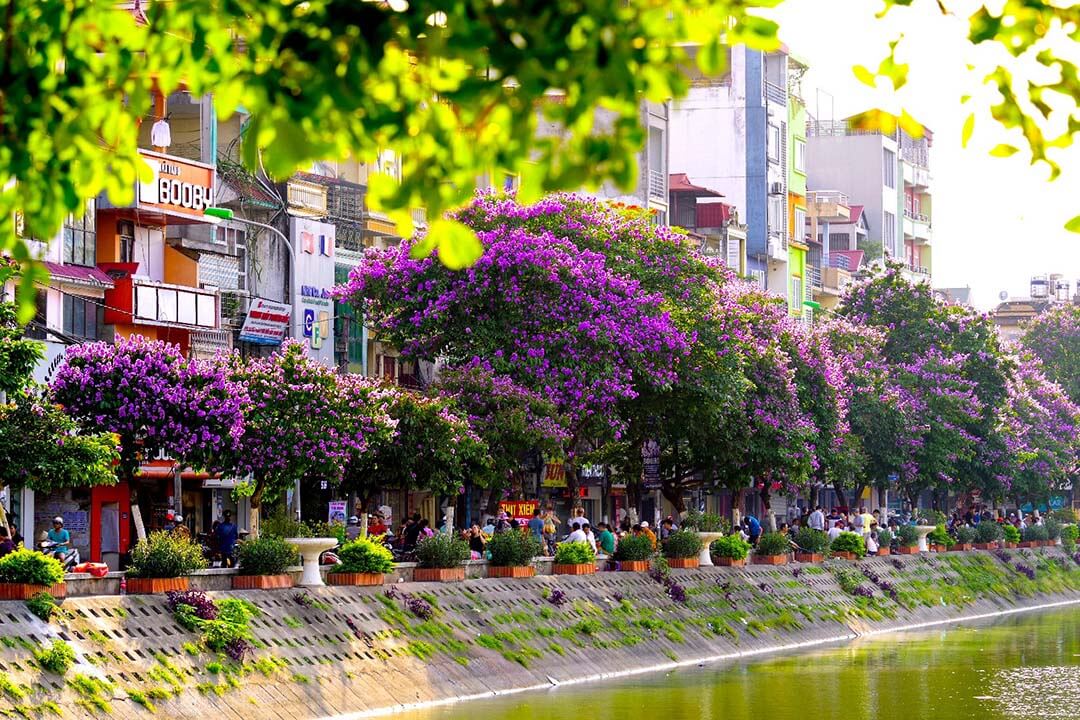
Autumn seasons in Northern (September to November)
Autumn is considered the most beautiful season of the year in the North, especially in Hanoi. The weather during this season is cooler and drier. Temperatures range from 20°C to 25°C (68°F to 77°F), making it an ideal time for sightseeing with lower humidity. The cooler temperatures and reduced rainfall make it perfect for outdoor activities like trekking in Sapa, cruising in Halong Bay, and exploring Hanoi’s historical sites. The autumn foliage adds an extra layer of beauty to the landscape, enhancing the overall travel experience.

Attractions you might be interested in Hanoi:
Winter season in Northern (December to February)
The Vietnam winter in the North can be surprisingly cold, especially in mountainous areas. Temperatures can drop to 5°C (41°F) in Hanoi and even lower in places like Sapa, where frost and occasional snowfall occur. This season is dry and clear, but chilly, particularly in January. Visitors should pack warm clothing, especially if traveling to higher altitudes. Despite the cold, winter in Northern Vietnam has its charm, with the clear skies providing excellent visibility for sightseeing. The festive atmosphere around the Lunar New Year, with various cultural celebrations, also adds to the unique experience of visiting Northern Vietnam in winter.
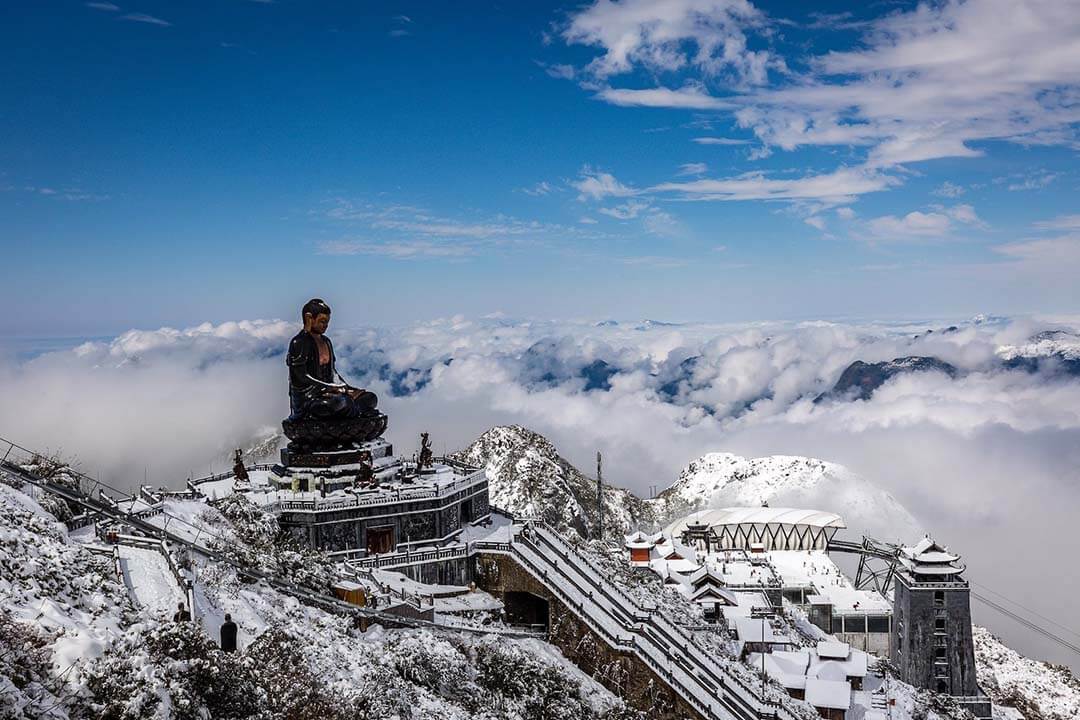
Winter is a great time to explore historical sites in Hanoi and experience the unique charm of the northern highlands. The cooler weather is perfect for leisurely walks and cultural tours.
Central Vietnam weather
Central Vietnam, including cities like Hue (Huế), Da Nang, and Hoi An, has a tropical monsoon climate. This region has two main seasons: the dry season and the rainy season. The Vietnam climate in Central Vietnam is influenced by both the northeast and southwest monsoons, leading to distinct seasonal variations.
The dry season in Central (February to August)
The Vietnam climate during the dry season in Central is warm and dry, with temperatures ranging from 20°C to 35°C (68°F to 95°F). This season is characterized by clear skies and minimal rainfall, making it an ideal time for outdoor activities and beach excursions. December to February is cooler, with temperatures being more comfortable for travelers.
This is a popular time for visiting cultural sites like the ancient town of Hoi An and the imperial city of Hue. March and April are the hottest months, with temperatures peaking, which can make mid-day activities less comfortable but perfect for beach lovers.
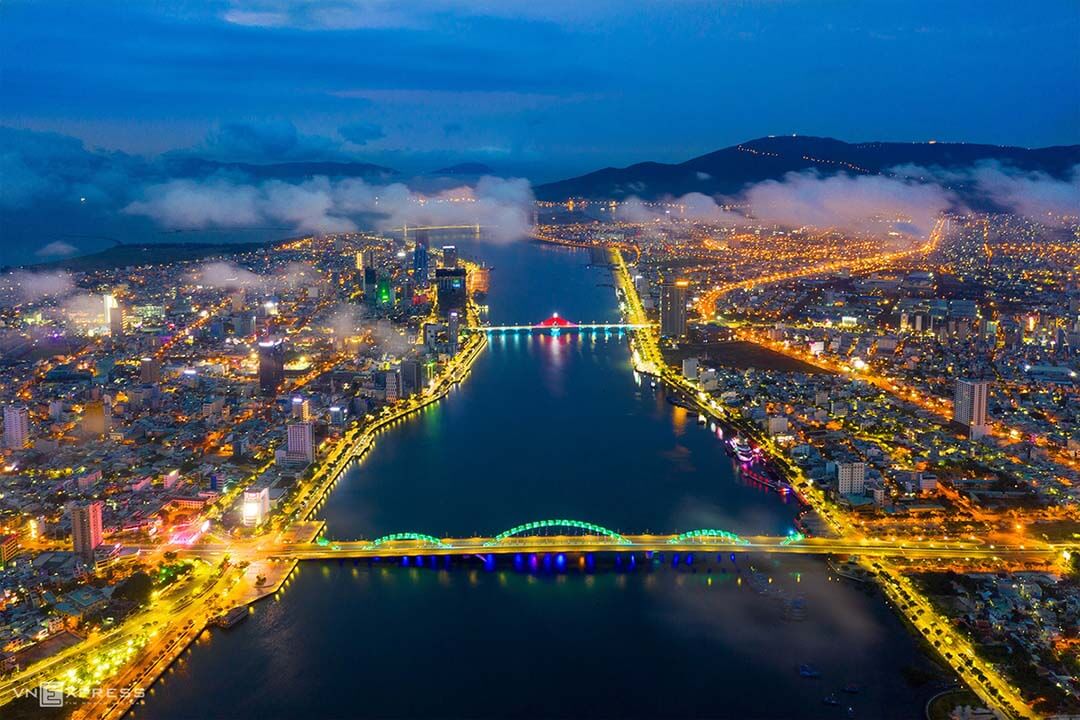
The rainy season in Central (September to January)
The rainy season in Central Vietnam brings heavy rainfall, especially in October and November. Temperatures range from 23°C to 30°C (73°F to 86°F), with frequent showers usually occurring in the afternoon. This period also has higher humidity levels, which can make it feel warmer than it is.
The rain can sometimes lead to flooding in low-lying areas, so travelers need to stay informed about weather conditions. Despite the rain, this season offers unique experiences such as visiting the historical sites in Hue, enjoying indoor activities in Da Nang, and exploring the cultural heritage of Hoi An. The lush green landscapes during the rainy season can be quite beautiful.
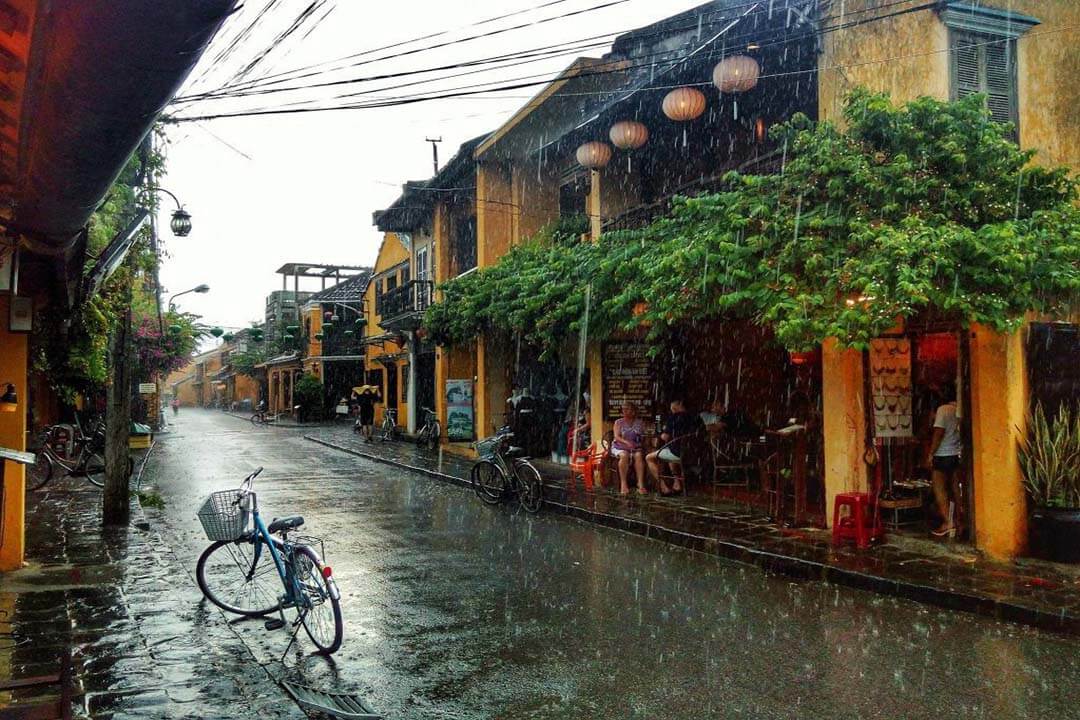
Detailed overview
Central Vietnam’s climate is quite diverse due to its geographical features and coastal location. Understanding the seasonal changes can help travelers make the most of their visit to this beautiful region.
- February to April: These months mark the transition from the cooler months to the warmer ones. The weather is generally pleasant with mild temperatures and low humidity. It’s a great time to visit the beaches in Da Nang or the historic sites in Hue and Hoi An without the discomfort of extreme heat.
- May to August: These are the peak summer months with high temperatures and increased humidity. The beaches are popular destinations during this time, and the clear skies are perfect for beach activities and water sports. However, it’s important to stay hydrated and protect yourself from the sun.
- September to November: The onset of the rainy season brings significant rainfall, particularly in October and November. While frequent showers can be a drawback, this is also the time when the region’s landscapes are most lush and vibrant. The rain can sometimes be heavy, but it usually comes in short bursts.
- December to January: These months see a mix of cooler temperatures and the tail end of the rainy season. The weather is more stable and cooler compared to the previous months, making it comfortable for exploring the region. This period also sees fewer tourists, providing a more serene experience at popular attractions.
Southern Vietnam weather
Southern Vietnam, encompassing vibrant cities like Ho Chi Minh City, the lush Mekong Delta, and the picturesque Phu Quoc Island, has a tropical climate characterized by minimal temperature variation throughout the year. This region has two distinct seasons: the dry season and the rainy season.
Things you might be interested in:
The dry season in Southern (November to April)
The climate in Southern Vietnam during the dry season is hot and dry, with temperatures ranging from 25°C to 35°C (77°F to 95°F). This period is characterized by clear skies, high temperatures, and lower humidity, making it a popular time for tourists.
December to February is relatively cooler and more comfortable, with temperatures dropping slightly, creating ideal conditions for exploring the bustling streets of Ho Chi Minh City or enjoying the beaches of Phu Quoc Island.
March and April are the hottest months, with temperatures often reaching their peak. The heat can be intense, particularly in the afternoons, so it is essential to stay hydrated and protect yourself from the sun.
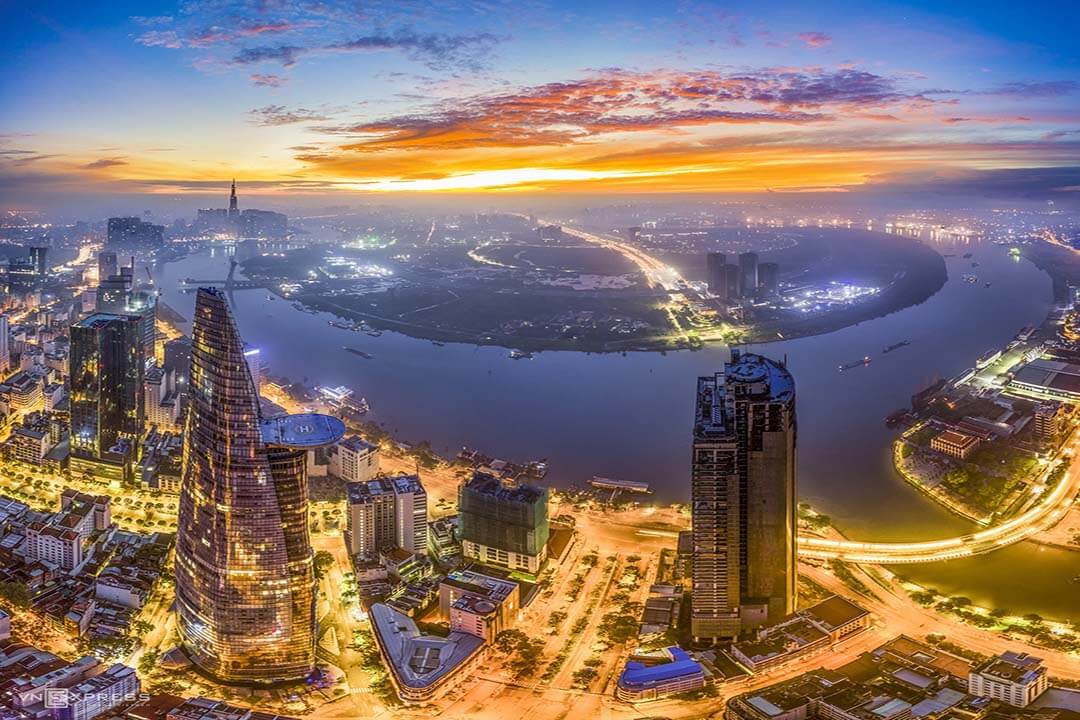
The rainy season in Southern (May to October)
The rainy season in Southern Vietnam runs from May to October, with the heaviest rainfall typically occurring from June to August. During this period, temperatures range from 25°C to 30°C (77°F to 86°F). Rainfall is frequent but usually falls in short, intense bursts, often in the late afternoon or evening. The showers can be heavy, leading to temporary flooding in some areas. Despite the rain, this season is a great time to explore the indoor attractions of Ho Chi Minh City, visit the floating markets of the Mekong Delta, and enjoy the lush green scenery of the countryside.
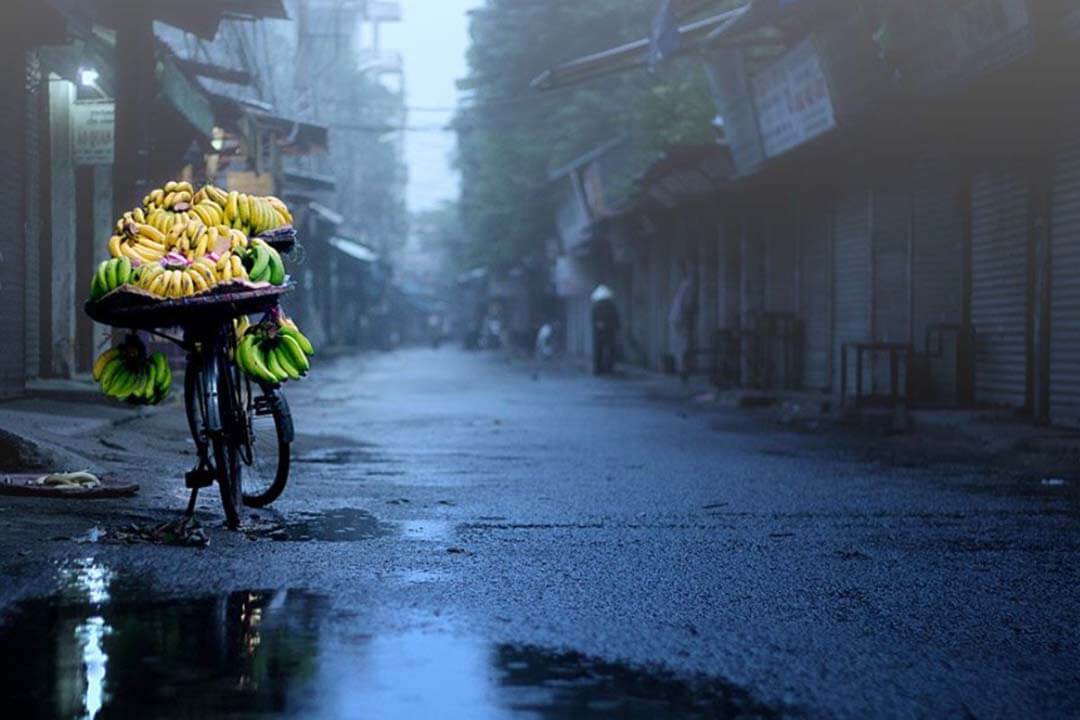
Detailed overview
Southern Vietnam’s climate is relatively stable compared to other regions, but understanding the seasonal variations can enhance your travel experience.
- November to February: This is the dry season’s cooler period, offering pleasant weather for exploring cities and enjoying outdoor activities such as sightseeing, visiting flooding markets, and enjoying the diverse food scene in Ho Chi Minh City.
- March to April: These are the hottest months of the year in Southern Vietnam. The temperatures rise, making it ideal for beach activities and water sports in destinations like Phu Quoc Island. However, the heat can be intense, so it’s important to take precautions against sun exposure and stay hydrated.
- May to August: This period marks the height of the rainy season. The frequent, heavy rain showers can provide relief from the heat, but they can also disrupt travel plans. The Mekong Delta becomes particularly vibrant during this time, with lush landscapes and flowing rivers. While the rain can be intense, it usually does not last all day, allowing for periods of clear weather.
- September to October: Rainfall begins to decrease as the rainy season transitions into the dry season. The weather remains warm, but the frequency of heavy rains diminishes, making it a good time for travel. The temperatures are still high, but the weather is generally more stable compared to the peak rainy months.
Vietnam monthly weather
Understanding the Vietnam weather by month is essential for planning your trip to this beautiful country. The temperature in Vietnam varies significantly across different regions and months, providing diverse experiences throughout the year.
Vietnam weather in January
- Northern, experiences cool and dry conditions, with average temperatures ranging from 10°C to 20°C (50°F to 68°F). This is an ideal time to visit Hanoi and Halong Bay, where the crisp winter air and clear skies create perfect conditions for sightseeing and exploring. The cooler weather is also great for walking tours in Hanoi’s Old Quarter and taking scenic cruises in Halong Bay.
- Central Vietnam, including cities like Hue and Da Nang, enjoys warm and dry weather during January, with temperatures between 18°C and 25°C (64°F and 77°F). This pleasant climate makes it a perfect time to explore the historical sites in Hue, such as the Imperial City, and to relax on the beautiful beaches of Da Nang. The mild temperatures and clear skies are ideal for outdoor activities and exploring the ancient town of Hoi An.
- In Southern Vietnam, which encompasses Ho Chi Minh City and the Mekong Delta, January is characterized by hot and dry weather, with temperatures ranging from 25°C to 35°C (77°F to 95°F). This period is excellent for beach activities in places like Phu Quoc and Vung Tau. Additionally, it’s a great time to explore the vibrant street life of Ho Chi Minh City and visit the floating markets of the Mekong Delta, where the dry weather ensures easy travel and comfortable exploration.
Vietnam weather in February
- In February, Northern Vietnam continues to enjoy cool and dry conditions, with temperatures ranging from 15°C to 20°C (59°F to 68°F). This is an excellent time to visit Hanoi, where you can experience the city’s cultural heritage and explore its historical landmarks without the intense summer heat. Additionally, the cooler temperatures make it ideal for a visit to the picturesque landscapes of Halong Bay.
- Central Vietnam maintains its pleasant weather in February, with temperatures between 20°C and 30°C (68°F and 86°F). This mild and dry climate is perfect for sightseeing in Hue, where you can visit the ancient Imperial City and explore the city’s rich history. Da Nang’s beautiful beaches are also inviting during this time, providing a great opportunity to relax by the sea. The favorable weather conditions extend to Hoi An, where you can wander through its charming old town and enjoy the lantern festivals that light up the streets.
- Southern Vietnam remains warm and dry in February, with temperatures around 25°C to 35°C (77°F to 95°F). This is an ideal time for beachgoers to visit Phu Quoc Island or the coastal city of Nha Trang, where you can enjoy sunny days and warm waters. The dry weather also makes it a good time to explore the bustling markets and vibrant street scenes in Ho Chi Minh City, as well as take a boat trip through the Mekong Delta to experience the unique floating markets and local culture.
Vietnam weather in March
- In March, Northern Vietnam begins to transition into spring, with temperatures ranging from 20°C to 25°C (68°F to 77°F). This period features pleasant weather, making it an excellent time to explore the region’s natural beauty and cultural sites. The blooming landscapes around Hanoi are perfect for outdoor activities, and the moderate temperatures provide comfortable conditions for visiting landmarks like the Temple of Literature and the Hoan Kiem Lake. Halong Bay remains a top destination with its clear skies and mild weather, ideal for cruising and sightseeing.
- Central Vietnam enjoys warm and dry weather in March, with temperatures between 22°C and 30°C (72°F and 86°F). This is an ideal time to visit the historical sites of Hue, as the weather is conducive to exploring the Imperial City and surrounding areas. The beaches in Da Nang and Hoi An offer pleasant conditions for sunbathing and swimming. The dry weather also makes it a good time for outdoor activities, such as hiking in the Ba Na Hills or exploring the ancient town of Hoi An, known for its charming streets and cultural heritage.
- Southern Vietnam experiences hot and dry conditions in March, with temperatures reaching up to 35°C (95°F). This is the perfect time for beach enthusiasts to visit places like Phu Quoc Island and the coastal city of Nha Trang, where you can enjoy sunny days and warm waters. Ho Chi Minh City remains vibrant and lively, with its numerous markets and street food scenes. The dry weather also makes it an excellent time for exploring the Mekong Delta, where you can take boat trips and visit the unique floating markets.
Vietnam weather in April
- In April, Northern Vietnam enjoys warmer temperatures ranging from 22°C to 28°C (72°F to 82°F). This period continues the pleasant spring weather, making it a great time to explore Hanoi’s historical sites and natural beauty. The blooming flora around Halong Bay enhances the scenic cruises, and the comfortable temperatures are perfect for hiking in the nearby areas, such as the stunning terraced fields in Sapa.
- Central Vietnam becomes hotter and drier in April, with temperatures ranging from 25°C to 35°C (77°F to 95°F). This weather is ideal for visiting the ancient city of Hue and the beautiful beaches of Da Nang and Hoi An. The clear skies and warm temperatures are great for outdoor activities, including exploring the Marble Mountains or enjoying the coastal scenery in Hoi An. The dry conditions also provide excellent opportunities for sightseeing and enjoying the vibrant cultural festivals in Hoi An.
- Southern Vietnam continues to experience hot and dry weather in April, with temperatures between 25°C and 35°C (77°F to 95°F). This is an excellent time to visit beach destinations like Phu Quoc and Nha Trang, where the weather is perfect for relaxation and water activities. In Ho Chi Minh City, the dry weather allows for easy exploration of the city’s attractions and markets. The Mekong Delta also offers a unique experience with its floating markets and lush landscapes, best enjoyed in the clear, sunny conditions of April.
Vietnam weather in May
- May marks the beginning of the rainy season in Southern Vietnam, with frequent afternoon showers. Despite the rain, the temperatures remain high, ranging from 25°C to 35°C (77°F to 95°F).
- Northern Vietnam experiences warm and humid conditions, with temperatures climbing as summer approaches.
- Central Vietnam remains relatively dry, although the humidity starts to increase. This month is a transitional period, so it’s important to prepare for varying weather conditions.
Vietnam weather in June
- June is hot and humid in Northern Vietnam, with temperatures reaching up to 35°C (95°F). The weather is quite warm, with frequent rain showers and high humidity. This is a good time for exploring cooler highland areas like Sapa, where you can escape the heat and enjoy the stunning terraced fields and local culture.
- Central Vietnam experiences significant rainfall in June, with temperatures between 25°C and 35°C (77°F and 95°F). The rains can be heavy, but there are still plenty of dry periods to visit the historic sites of Hue and the beaches of Da Nang. Hoi An also offers beautiful scenery despite the rain, and the occasional downpours add to the lush environment.
- In Southern Vietnam, June continues the rainy season with high humidity and frequent afternoon showers. Temperatures remain high, between 24°C and 33°C (75°F and 91°F). The rain provides a refreshing break from the heat, and the weather is still suitable for beach activities and exploring Ho Chi Minh City’s attractions. The Mekong Delta’s water levels rise, enhancing boat trips and floating market visits.
Vietnam weather in July
- July remains hot and humid in Northern Vietnam, with temperatures reaching up to 35°C (95°F). The weather is characterized by high humidity and frequent rain showers. This is a good time for highland escapes to cooler areas like Sapa or to explore indoor attractions and museums in Hanoi.
- In Central Vietnam, July continues with significant rainfall, with temperatures between 25°C and 35°C (77°F and 95°F). The rain can be heavy, but it is still possible to enjoy sightseeing in Hue and relaxing on Da Nang’s beaches during the drier periods. Hoi An remains a charming destination with lush scenery despite the rain.
- Southern Vietnam’s rainy season continues in July, with high humidity and frequent thunderstorms. Temperatures remain high, between 24°C and 33°C (75°F and 91°F). Despite the rain, it’s a good time for indoor activities in Ho Chi Minh City and to visit Phu Quoc Island or the Mekong Delta, where the rain enhances the lush landscapes.
Vietnam weather in August
- August is one of the wet seasons in Vietnam, with heavy rainfall and high humidity. Temperatures range from 25°C to 35°C (77°F and 95°F). In Central, The frequent rain can be heavy, but it’s still possible to explore Hue’s historical sites and Da Nang’s beaches during the drier intervals. Hoi An’s picturesque streets are also worth visiting, even with the occasional downpour.
- Northern Vietnam continues to be hot and humid in August, with temperatures reaching up to 35°C (95°F). The weather remains warm and rainy, making it a good time for cooler highland areas like Sapa or indoor activities in Hanoi. The rain adds to the lushness of the landscape and can enhance outdoor experiences in cooler regions.
- In Southern Vietnam, August continues the rainy season with high humidity and frequent showers. Temperatures remain high, between 24°C and 33°C (75°F and 91°F). Despite the rain, it’s still suitable for beach activities in places like Phu Quoc and Nha Trang. Ho Chi Minh City’s vibrant street life and the Mekong Delta’s floating markets can be explored with the added charm of the rainy season.
Vietnam weather in September
- September marks the beginning of Vietnam rainy season to drier conditions in Northern Vietnam, with temperatures ranging from 25°C to 30°C (77°F to 86°F). The weather starts to cool down, making it a good time to explore Hanoi’s historical sites and Halong Bay’s scenic beauty. The landscapes are lush from the previous rains, providing beautiful backdrops for travel.
- Central Vietnam remains rainy in September, with heavy rainfall and temperatures between 25°C and 35°C (77°F and 95°F). While the rain can be frequent, there are still opportunities to visit Hue’s historic sites and relax on Da Nang’s beaches during the drier periods. The scenery in Hoi An is enhanced by the rain, making it a picturesque destination.
- Southern experiences the rainy season in Vietnam in September, with high humidity and frequent showers. Temperatures remain between 24°C and 33°C (75°F and 91°F). Despite the rain, it’s a good time to explore Ho Chi Minh City’s attractions and enjoy the Mekong Delta’s unique floating markets. The rain adds to the lushness of the region’s landscapes.
Vietnam weather in October
- In October, Northern Vietnam starts to cool down further, with temperatures ranging from 20°C to 28°C (68°F to 82°F). The weather becomes more comfortable, making it an excellent time for exploring Hanoi and taking scenic cruises in Halong Bay. The pleasant temperatures and reduced humidity are ideal for outdoor activities and sightseeing.
- Central Vietnam continues to experience heavy rainfall in October, with temperatures between 25°C and 35°C (77°F and 95°F). The rains can be frequent and intense, but there are still opportunities to visit Hue and Da Nang’s attractions. Hoi An’s charming streets are also worth visiting despite the rain, with the occasional sunshine breaking through.
- Southern Vietnam sees the rainy season beginning to taper off in October, with high humidity and occasional showers. Temperatures remain between 24°C and 33°C (75°F and 91°F). This is a good time to visit Ho Chi Minh City and explore the Mekong Delta, as the rain starts to decrease and the lush landscapes are still vibrant.
Vietnam weather in November
- November marks the transition to drier weather in Northern Vietnam, with temperatures ranging from 18°C to 25°C (64°F to 77°F). The cooler and drier conditions are ideal for exploring Hanoi’s cultural sites and enjoying the scenic beauty of Halong Bay. The clear skies and comfortable temperatures make it a great time for outdoor activities and sightseeing.
- In Central Vietnam, rainfall decreases significantly in November, with temperatures between 20°C and 30°C (68°F and 86°F). The drier weather provides excellent conditions for visiting Hue, relaxing on Da Nang’s beaches, and exploring Hoi An’s picturesque streets. The reduced rainfall enhances the region’s natural beauty and makes outdoor activities more enjoyable.
- Southern Vietnam continues to experience drier weather in November, with temperatures ranging from 24°C to 33°C (75°F to 91°F). This is an excellent time for beach activities in Phu Quoc and Nha Trang, as well as exploring Ho Chi Minh City and the Mekong Delta. The lower humidity and less frequent rain make November a great time for travel in Southern Vietnam.
Vietnam weather in December
- In December, Northern Vietnam experiences cool and dry conditions, with temperatures ranging from 15°C to 20°C (59°F to 68°F). This is a pleasant time to visit Hanoi and Halong Bay, where you can enjoy the crisp winter air and clear skies. The cooler temperatures are ideal for exploring the region’s cultural and natural attractions.
- Central Vietnam enjoys mild weather in December, with temperatures between 18°C and 25°C (64°F and 77°F). This is a great time to visit Hue’s historical sites, relax on Da Nang’s beaches, and wander through the charming streets of Hoi An. The reduced rainfall and comfortable temperatures provide excellent conditions for travel and outdoor activities.
- Southern Vietnam experiences warm and dry weather in December, with temperatures ranging from 25°C to 35°C (77°F to 95°F). This is an ideal time for beach activities in places like Phu Quoc and Nha Trang. Ho Chi Minh City’s vibrant markets and the Mekong Delta’s unique floating markets are also enjoyable during the dry season, making December a great time to explore Southern Vietnam.

Best time to visit Vietnam
Vietnam is a fantastic destination any time of the year, but certain months offer particularly favorable conditions. The best time to visit Vietnam is between October and May when the climate across different regions is generally pleasant. This period avoids the peak of the rainy season in the south and central areas, as well as the extreme heat of the summer months in the north. Specifically, autumn (September to November) and spring (March to April) stand out for their ideal weather and fewer crowds.
Autumn (September to November): During these months, Vietnam enjoys cooler temperatures and dry weather. Northern regions, including Hanoi and Halong Bay, are especially appealing with comfortable temperatures and clear skies, perfect for exploring. The central coast, including Hoi An and Da Nang, also offers pleasant weather with reduced rainfall compared to the peak rainy season. This is an excellent time for sightseeing and outdoor activities without the disruption of heavy rain.
Spring (March to April): Spring in Vietnam brings mild temperatures and clear skies across the country. Northern Vietnam is adorned with blooming flowers, creating picturesque landscapes ideal for exploration. Meanwhile, Central and Southern Vietnam experience warm and dry conditions, making it an excellent time to enjoy the beaches and historical sites. This period is perfect for outdoor activities and sightseeing, offering a balance of comfortable weather and fewer tourists.
Traveling during these optimal times allows you to experience Vietnam at its best, avoiding the extremes of weather and taking advantage of fewer crowds and potentially better travel deals. Whether you visit during the pleasant autumn or the refreshing spring, you’re sure to have a memorable experience exploring the diverse beauty of Vietnam.
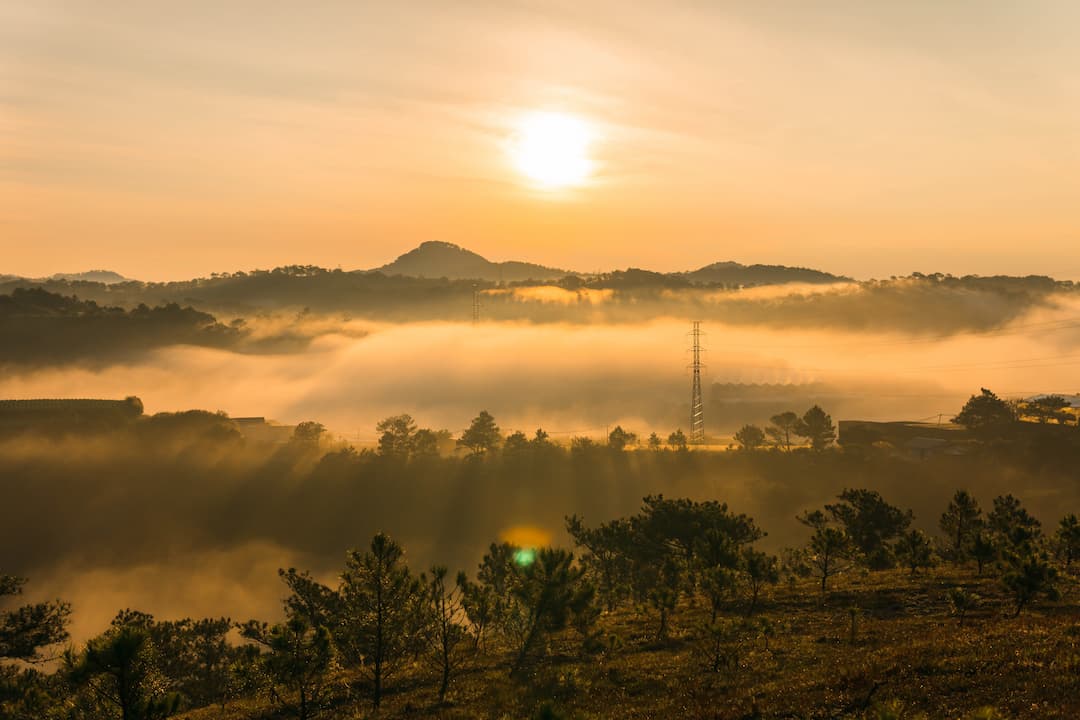
Common questions about the weather in Vietnam
Understanding common questions about Vietnam weather can help you plan your trip better.
When is the wet season in Vietnam?
The wet season in Vietnam varies by region.
- In the South, it runs from May to October, characterized by frequent and heavy rainfall, particularly in the afternoons.
- In the central region, the wet season typically spans from September to December, often resulting in flooding due to prolonged rain.
- Northern Vietnam experiences its wet season from May to August, with high humidity and heavy showers, although the rains are usually less intense compared to the central region.
Does it get cold in Vietnam?
- Northern Vietnam can get quite cold during winter, especially in mountainous areas. In cities like Hanoi and Sapa, temperatures can sometimes drop below 5°C (41°F) from December to February. Frost and occasional snowfall can occur in high-altitude areas such as Sapa.
- The rest of the country, including central and southern regions, generally remains warm year-round.
- Central Vietnam experiences milder winters, while Southern Vietnam stays hot and humid, with temperatures rarely falling below 20°C (68°F).
Understanding the Vietnam season is key to planning an enjoyable trip. With diverse weather patterns across the country, each region offers a unique experience throughout the year. By considering the climate and planning accordingly, you can ensure a comfortable and memorable journey, visit our blog for comprehensive Vietnam Travel Tips.


